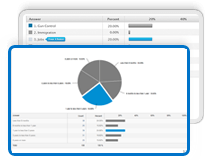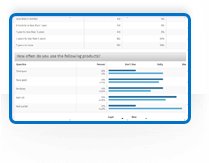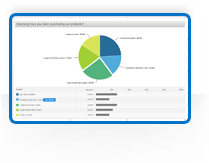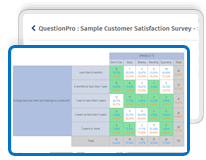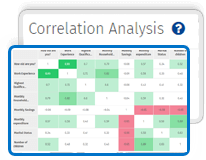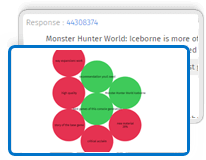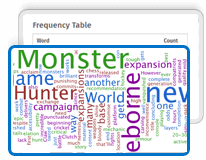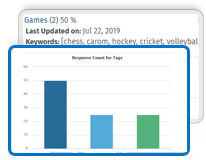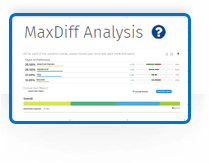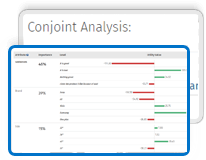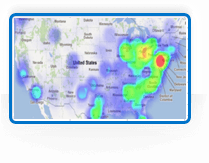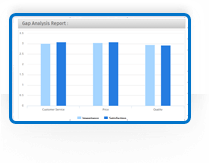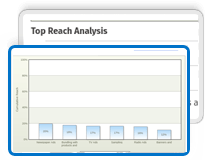A wide range of ready-made reports with filters to make the most of your survey results.
Real-Time Summary Report
The Real-Time Summary Report is the most basic report for up-to-date survey results. It consists of simple frequency statistics and basic graphs of the data collected.
Learn more
Online Comparison Report
After viewing the entire dataset in the online summary report, a common requirement is to compare the results of the survey for different groups of survey respondents. This report shows the overall results, as well as results for each group you have defined.
Learn more
Spotlight Report ™
The spotlight report allows respondents to visually see how their responses compare to the overall survey responses.
Learn more
Individual Response Viewer
In many cases, data analysis requires drilling down to one particular survey response. From any point in the online analysis, you have the option to query the responses and bring up a list of survey responses to view one by one. The data includes the IP Address, Date/Time, and any custom variables you may have collected for the respondent.
Cross-Tabulation
The cross-tabulation tool lets you measure the interaction between two or more categorical variables. The table shows only respondents that answered all the questions, meaning the frequencies may differ from a standard frequency table. The cross-tab report also includes Pearson’s Chi-Square Statistics, showing the correlation level between the variables using the chi-square, p-value, and degrees of freedom, along with row and column percentages, and highlighting the most significant cells.
Learn more
Correlation Analysis
Correlation Analysis measures the strength of association between two variables and the direction of the relationship. The correlation coefficient (rs) varies between +1 and -1. As the value goes towards 0, the relationship between the variables will be weaker. A + sign indicates a direct relationship and a - sign indicates an inverse relationship.
Learn more
Sentiment Analysis
Sentiment Analysis uses natural language processing, text analysis, computational linguistics, and biometrics to systematically identify, extract, quantify, and study affective states and subjective information. It's widely applied to customer materials like reviews and survey responses, online and social media, and healthcare materials for various applications.
Learn more
Word Cloud
A word cloud is a visual depiction of user-generated tags, or the word content of a site, used to describe its content. Tags are usually single words, listed alphabetically, with importance shown by font size or color.
Learn more
Text Categorization & Tagging
The text categorization and tagging tool allows you to tag open-ended text and categorize data based on tags. Users can mention keywords for auto-tagging or opt for manual tags.
Learn more
MaxDiff Analysis
MaxDiff is a methodology for interval scale measurements based on comparative judgments. Respondents select the most and least preferred items in a set.
Learn more
Conjoint Analysis
Conjoint Analysis is a quantitative measurement of consumer behavior. Unlike traditional ratings, it places importance or value on different product or service attributes.
Learn more
HeatMap Analysis
A heat map analysis graphically represents data with colors, showing density. Darker colors represent higher density.
Learn more
Trend Analysis
Studies over time can be analyzed with the Trend Analysis report to see how survey results vary. Results can be charted weekly, monthly, or quarterly.
Learn more
Gap Analysis
Gap Analysis analyzes the interaction of two scale-type questions. It determines the gap in two scales to prioritize attributes.
Learn more
TURF Analysis
TURF Analysis (Total Unduplicated Reach and Frequency) helps in estimating media or market potential and devising optimal ways to use it given limited resources. It can assist companies in deciding which products/services to offer and what not to make.
Learn more
Survey Software Easy to use and accessible for everyone. Design, send and analyze online surveys.
Research Suite A suite of enterprise-grade research tools for market research professionals.
Customer Experience Experiences change the world. Deliver the best with our CX management software.
Employee Experience Create the best employee experience and act on real-time data from end to end.
